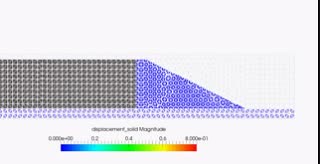Investigation of soil/water interactions with the Material Point Method (MPM)
Dongfang Liang, Kenichi Soga, Xuanyu Zhao
The accurate understanding of the dynamic interactions between soil and water is important in many aspects of civil engineering, e.g. the seepage flow through embankments, debris flows and submarine landslides. Water flow can erode soil particles and change the effective stress in the soil.
When the soil experiences large deformations, the widely-used Finite Element Method (FEM) often encounters many computational difficulties. The modern mesh-free computational techniques offer new opportunities for analysing these problems. In particular, the Material Point Method makes use of both discrete Lagrangian interpolation points and the Eulerian mesh in the computation, combining the advantages of both approaches. MPM makes it extremely easy to implement history-dependent constitutive models, because state variables, such as strain and stress, are carried by Lagrangian points, which move with the materials and are automatically tracked. The use of a background mesh in the MPM allows for the implementation of boundary conditions in a manner similar to that in the FEM, whereas many other meshfree methods find it challenging to accurately incoporate the boundary conditions.
In collaboration with Deltares in the Netherlands (www.deltares.nl), we developed a dual-particle MPM model, with one set of particles representing water and the other set of particles representing soil. These two types of particles are allowed to occupy the same location but with different velocities, so that the pore water can move relative to the soil skeleton. The behaviour of the dry soil, pure water and saturated soil can be modelled in a unified framework. In this dual-particle formulation, the momentum conservative equations are solved to obtain the acceleration of the solid skeleton and the fluid phase separately. The momentum exchange is considered by way of the drag force. Where water and soil particles coexist in an element, Terzaghi’s effective stress concept is applied.
The dual-particle MPM model opens up opportunities to simulate a wide range of problems involving strong soil/water interactions. As an example, the figures and animation show the collapsing process of an embankment under the action of seepage flow. Water is represented by black particles, and the soil embankment is represented by blue particles. The bottom is impermeable. The contours indicate the magnitude of the embankment soil displacement. In the simulation, the problem is assumed to satisfy the plane-strain condition. The soil’s intrinsic permeability is updated using the Kozeny-Carman formula.
For more information about the project, please visit http://mpm-dredge.eu/home
Please click on the image below to play the video.
Instability of the soil embankment subject to seepage flow
Larger images can be found here:

